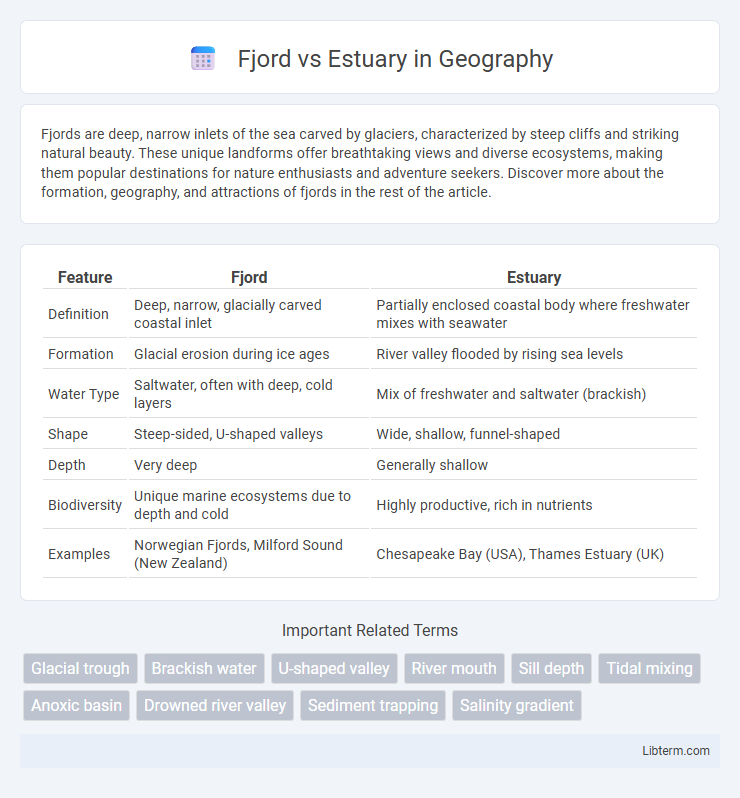Fjords are deep, narrow inlets of the sea carved by glaciers, characterized by steep cliffs and striking natural beauty. These unique landforms offer breathtaking views and diverse ecosystems, making them popular destinations for nature enthusiasts and adventure seekers. Discover more about the formation, geography, and attractions of fjords in the rest of the article.
Table of Comparison
| Feature | Fjord | Estuary |
|---|---|---|
| Definition | Deep, narrow, glacially carved coastal inlet | Partially enclosed coastal body where freshwater mixes with seawater |
| Formation | Glacial erosion during ice ages | River valley flooded by rising sea levels |
| Water Type | Saltwater, often with deep, cold layers | Mix of freshwater and saltwater (brackish) |
| Shape | Steep-sided, U-shaped valleys | Wide, shallow, funnel-shaped |
| Depth | Very deep | Generally shallow |
| Biodiversity | Unique marine ecosystems due to depth and cold | Highly productive, rich in nutrients |
| Examples | Norwegian Fjords, Milford Sound (New Zealand) | Chesapeake Bay (USA), Thames Estuary (UK) |
Introduction to Fjords and Estuaries
Fjords are deep, narrow inlets formed by glacial activity, characterized by steep cliffs and significant depth, typically found in regions with a history of glaciation such as Norway, New Zealand, and Canada. Estuaries are coastal water bodies where freshwater from rivers mixes with saltwater from the ocean, creating nutrient-rich environments that support diverse ecosystems and serve as crucial habitats for fish and bird species. Both fjords and estuaries play vital roles in marine biodiversity, but fjords are primarily shaped by glacial processes, whereas estuaries result from the mixing of freshwater and tidal saltwater.
Defining Fjords: Key Characteristics
Fjords are deep, narrow inlets formed by glacial erosion, characterized by steep cliffs and a U-shaped valley profile. These geological features often extend several kilometers inland, with marine water that is typically cold and saline. Unlike estuaries, fjords have minimal freshwater mixing and are mainly influenced by marine conditions.
Defining Estuaries: Key Characteristics
Estuaries are coastal water bodies where freshwater from rivers and streams mixes with saltwater from the ocean, creating a unique brackish environment. They exhibit fluctuating salinity levels, supporting diverse ecosystems with high biological productivity and serving as vital nurseries for many aquatic species. Floodplains, tidal influences, and sediment deposition contribute to the dynamic characteristics distinct from deep, glacially-carved fjords.
Formation Processes: Fjords vs Estuaries
Fjords form through glacial erosion as glaciers carve deep, U-shaped valleys that later fill with seawater during glacial retreat, creating steep, narrow inlets. Estuaries develop where freshwater rivers meet the ocean, resulting in a mixing zone influenced by tides and sediment deposition, often forming broad, shallow basins. The contrasting formation processes highlight fjords' glacial origins versus estuaries' fluvial and marine interactions.
Geographic Distribution and Examples
Fjords are deep, glacially carved inlets primarily found in Norway, New Zealand, and Alaska, characterized by steep cliffs and narrow, elongated shapes. Estuaries occur at the mouths of rivers where freshwater mixes with seawater, commonly located along the Atlantic coast of the United States, the Thames Estuary in England, and the Chesapeake Bay. These coastal features differ significantly in origin and geographic distribution, with fjords shaped by glacial activity and estuaries formed by riverine sediment deposition and tidal influences.
Physical and Chemical Differences
Fjords are deep, glacially carved valleys flooded by seawater, characterized by steep cliffs and a U-shaped profile, whereas estuaries are shallow, partially enclosed coastal bodies of water where freshwater from rivers mixes with saltwater from the ocean. Physically, fjords often exhibit higher depth and lower water exchange rates compared to estuaries, leading to well-stratified layers with minimal sediment disturbance. Chemically, fjords typically have more stable saline concentrations and oxygen gradients due to limited mixing, while estuaries experience greater fluctuations in salinity, nutrients, and dissolved oxygen levels caused by tidal action and freshwater inflows.
Biodiversity and Ecosystems
Fjords, characterized by deep, glacially carved valleys filled with saline ocean water, support unique ecosystems with stratified water layers that sustain diverse marine species including cold-water corals and specialized fish adapted to low light and oxygen conditions. Estuaries, where freshwater from rivers meets and mixes with saltwater from the ocean, create nutrient-rich environments that promote high biodiversity and serve as crucial nurseries for many fish, bird, and invertebrate species. Both ecosystems play vital roles in supporting complex food webs and maintaining ecological balance but differ significantly in physical structure and salinity gradients that influence species composition and habitat complexity.
Economic and Cultural Importance
Fjords, characterized by their deep, glacially carved inlets, often support vibrant fishing industries and attract significant tourism, boosting local economies in regions like Norway and New Zealand. Estuaries, where freshwater meets seawater, provide rich biodiversity crucial for commercial fisheries and serve as key hubs for transportation, trade, and urban development, evident in cities such as New Orleans and Shanghai. Both fjords and estuaries hold cultural importance through their influence on local traditions, livelihoods, and heritage, with fjords inspiring maritime folklore and estuaries shaping ancient settlement patterns.
Environmental Threats and Conservation
Fjords face environmental threats such as pollution from nearby industrial activities and climate change-induced glacial melting, which disrupts their unique marine ecosystems. Estuaries are vulnerable to nutrient pollution, habitat loss due to urban development, and rising sea levels, leading to decreased biodiversity and water quality. Conservation efforts for both fjords and estuaries emphasize protecting water quality, restoring natural habitats, and implementing sustainable land-use practices to preserve these crucial coastal environments.
Summary: Key Differences Between Fjords and Estuaries
Fjords are deep, narrow inlets formed by glacial activity, characterized by steep cliffs and significant depth, while estuaries are tidal mouths of rivers where freshwater mixes with seawater, featuring diverse ecosystems with brackish water. Fjords typically have a U-shaped cross-section due to glacial carving, whereas estuaries exhibit varied shapes influenced by sediment deposition and tidal patterns. The ecological dynamics in fjords rely on cold, oxygen-rich waters, contrasting with estuaries' nutrient-rich environments that support abundant biodiversity.
Fjord Infographic

 libterm.com
libterm.com